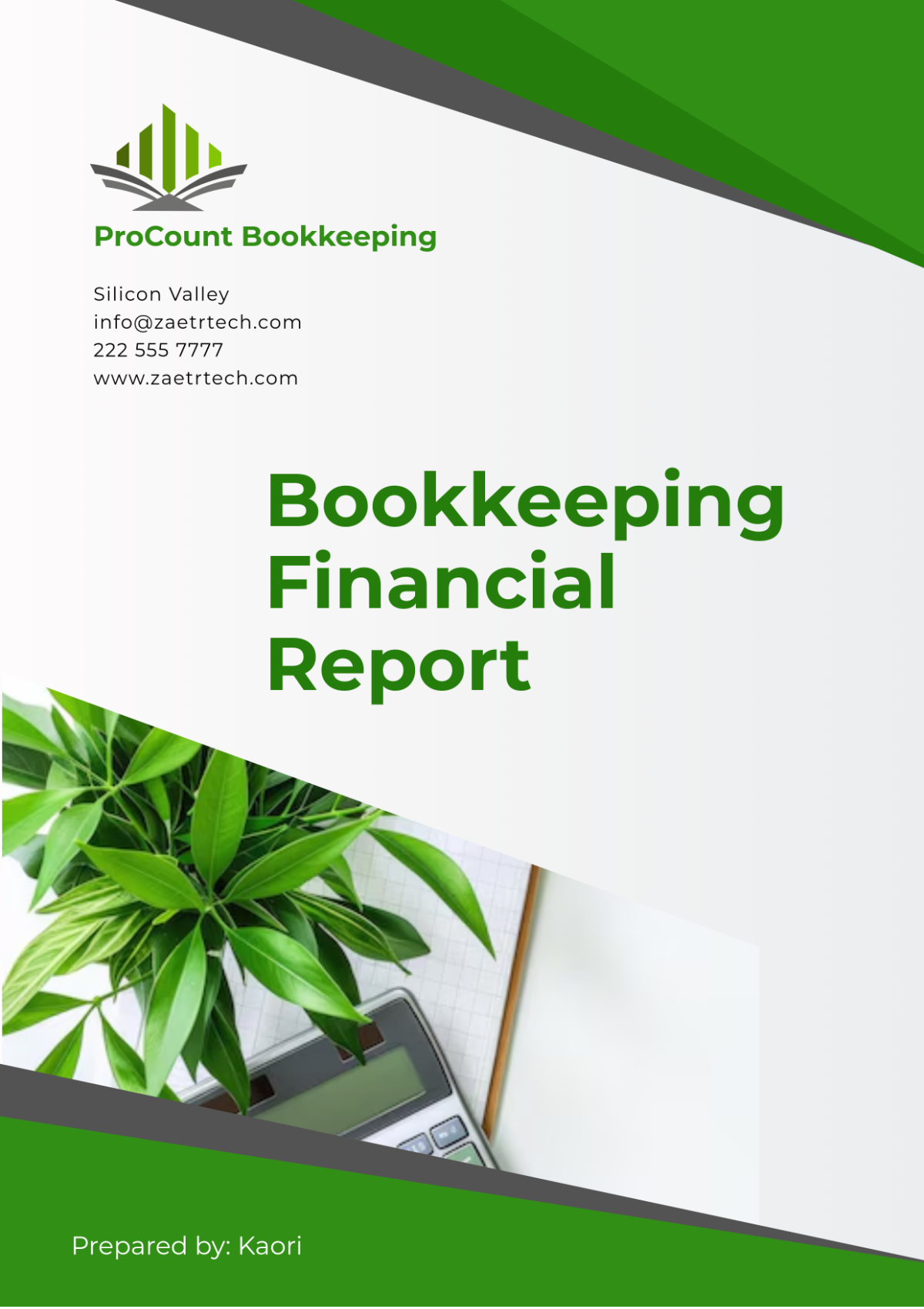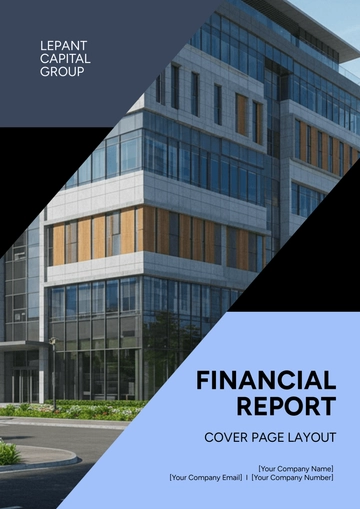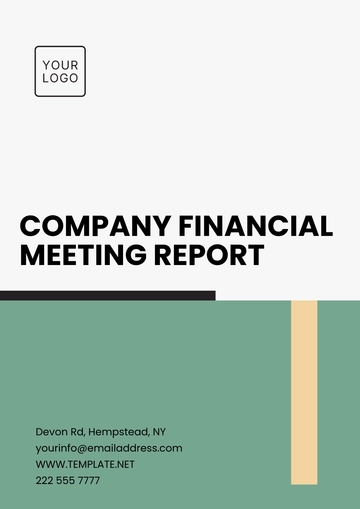Free Bookkeeping Financial Report

For
[Your Company Name]
For the Financial Year
2050
I. Executive Summary
The Bookkeeping Financial Report for [Your Company Name] for the fiscal year 2050 provides a comprehensive analysis of financial performance, cash flow management, and the overall health of the business. This report covers all financial aspects, including revenues, expenses, profits, and losses. The data is sourced from accurate bookkeeping records, ensuring compliance with financial standards and regulations.
The year 2050 was pivotal for [Your Company Name], with significant growth in revenue streams and a well-managed expense structure. Overall revenue increased by [15]% to $[3,300,000], reflecting effective strategies in marketing and sales as well as the successful launch of new products. This report details the income and expenditure breakdowns, accounts payable and receivable, and overall balance sheet health. It is designed to provide stakeholders with a thorough understanding of the financial landscape, thereby facilitating informed decision-making and strategic planning.
II. Income Statement
The income statement, also known as the profit and loss statement, shows the company’s revenue and expenses over the fiscal year, culminating in a net profit or loss figure. Below is a detailed breakdown of [Your Company Name]'s income statement for 2050.
A. Revenue Streams
Revenue is a critical indicator of the company's financial health. In 2050, [Your Company Name] generated revenue from multiple streams, including product sales, services, and investment returns. Below is the detailed breakdown:
Revenue Streams | Amount ($) | Percentage of Total Revenue (%) | Growth Rate (%) |
|---|---|---|---|
Product Sales | $[2,300,000] | [69.7] | [15] |
Service Revenue | $[850,000] | [25.8] | [20] |
Investment and Other Income | $[400,000] | [12.1] | [10] |
Total Revenue | $[3,300,000] | [100] | [15] |
1. Product Sales
Total revenue from product sales was $[2,300,000]. This represented a [15]% increase from the previous fiscal year’s figure of $[2,000,000].
Product sales accounted for approximately [70]% of the total revenue. This substantial portion underscores the company's focus on product innovation and market penetration.
Significant contributors to this growth were the launch of two new product lines that catered to emerging market demands, particularly in the eco-friendly segment, which saw heightened interest from consumers. Additionally, increased demand in key markets, including North America and Europe, significantly boosted sales figures.
2. Service Revenue
Revenue from services reached $[850,000], which is [20]% higher than the previous year’s amount of $[700,000].
The service division contributed [25]% of the total revenue, bolstered by long-term contracts with key clients, enhancing stability in this revenue stream.
New service offerings introduced mid-year, such as consulting and maintenance services, contributed to this growth, expanding the customer base and increasing customer retention rates.
3. Investment and Other Income
Income from investments and other non-operating activities totaled $[400,000], accounting for [12%] of the overall revenue.
A strategic portfolio of diversified investments, including stocks and bonds, was the primary contributor to this figure, with a focus on sustainability-oriented companies which saw higher returns in 2050.
B. Cost of Goods Sold (COGS)
The Cost of Goods Sold refers to the direct costs attributable to the production of the goods sold by [Your Company Name].
COGS for 2050 was $[1,350,000], representing [59%] of the total revenue. This figure shows a slight increase from $[1,200,000] in 2050.
This includes material costs, manufacturing expenses, and labor directly associated with production. The rise in COGS is mainly due to increased raw material prices and enhanced production capacity to meet growing demand.
C. Gross Profit
The gross profit is derived by subtracting the COGS from total revenue.
Gross profit for 2050: $[1,650,000], compared to $[1,700,000] in 2050
.
The gross profit margin stood at [50%], which, while slightly lower than the previous year’s [52]%, remains healthy and reflects effective cost management strategies despite rising material costs.
D. Operating Expenses
Operating expenses include costs required to run the business that are not directly tied to production.
Operating Expenses | Amount ($) | Growth Rate (%) |
|---|---|---|
Administrative Expenses | $[600,000] | [20] |
Marketing and Sales Expenses | $[400,000] | [33] |
Research and Development | $[250,000] | [25] |
Total Operating Expenses | $[1,250,000] | [23] |
1. Administrative Expenses
Administrative costs for the year amounted to $[600,000], covering salaries, office supplies, utilities, and general overheads. This shows an increase of [20]% from the previous fiscal year's expenses of $[500,000].
A [20]% increase in this category reflects investments in hiring new personnel to support growth, as well as the costs associated with upgrading office infrastructure to accommodate a growing workforce. Efficient management of these expenses will be crucial in maintaining profitability moving forward.
2. Marketing and Sales Expenses
Total marketing and sales expenditure for the year was $[400,000], accounting for [12%] of total revenue. This is a [33]% increase from the previous year's spending of $[300,000].
Increased spending in digital marketing campaigns and salesforce training led to a higher customer acquisition rate, with a focus on reaching new demographics. The implementation of data analytics tools to refine marketing strategies has proven effective in targeting advertising and optimizing return on investment.
3. Research and Development (R&D)
R&D costs were $[250,000], representing [8%] of total revenue, which shows a [25]% increase from $[200,000] in 2050.
Significant resources were allocated to the development of new products and technologies, especially in response to consumer trends toward sustainability, which are expected to contribute to future revenue growth. Investment in R&D ensures that [Your Company Name] remains competitive and innovative in an evolving marketplace.
E. Net Income Before Tax
After accounting for all operating expenses, [Your Company Name]'s income before tax was $[900,000].
F. Taxes
The tax liability for the company was $[180,000], based on a tax rate of [20]%. This reflects effective tax planning and utilization of tax deductions, enabling [Your Company Name] to retain a larger portion of its earnings for reinvestment.
G. Net Income After Tax
The final net income after taxes for the fiscal year 2050 is $[720,000], showing a solid bottom line and a favorable increase compared to $[500,000] in 2050.
III. Balance Sheet
The balance sheet provides a snapshot of the company's financial position at the end of the fiscal year. It includes assets, liabilities, and equity, which indicate how well the company is managing its financial obligations and investments.
A. Assets
Assets are the resources owned by the company that have future economic value.
Assets | Amount ($) |
|---|---|
Current Assets | |
Cash and Cash Equivalents | $[500,000] |
Accounts Receivable | $[400,000] |
Inventory | $[600,000] |
Non-Current Assets | |
Property, Plant, and Equipment (PP&E) | $[1,500,000] |
Intangible Assets | $[300,000] |
Total Assets | $[3,300,000] |
1. Current Assets
Cash and Cash Equivalents: $[500,000]
This amount represents cash reserves available for immediate use, which enhances liquidity and the company’s ability to respond to short-term financial needs.
Accounts Receivable: $[400,000]
The accounts receivable figure indicates the amount owed by clients to [Your Company Name] for services or products delivered. The average collection period was [45] days, which aligns with industry standards and demonstrates efficient credit management. Strategies to reduce this period further will enhance cash flow.
Inventory: $[600,000]
The inventory includes finished products and raw materials. Inventory turnover was [4] times, suggesting efficient inventory management and indicating that the company is not overstocking or tying up capital in unsold goods. Regular assessments of inventory levels and demand forecasts are essential to maintain this efficiency.
2. Non-Current Assets
Property, Plant, and Equipment (PP&E): $[1,500,000]
This includes company-owned land, buildings, machinery, and other physical assets used in operations. Regular maintenance and potential upgrades of PP&E will ensure ongoing operational efficiency.
Intangible Assets: $[300,000]
This value reflects the company's brand reputation, customer relationships, and intellectual property, which contribute significantly to competitive advantage. Continued investment in branding and customer loyalty initiatives will further enhance this intangible asset base.
B. Liabilities
Liabilities represent the company's financial obligations to external parties.
Liabilities | Amount ($) |
|---|---|
Current Liabilities | |
Accounts Payable | $[300,000] |
Short-Term Debt | $[150,000] |
Non-Current Liabilities | |
Long-Term Debt | $[600,000] |
Total Liabilities | $[1,100,000] |
1. Current Liabilities
Accounts Payable: $[300,000]
This figure represents amounts owed to suppliers and vendors for products and services received. The company maintains good relationships with suppliers, allowing for favorable payment terms.
Short-Term Debt: $[150,000]
This includes obligations due within the next [12] months. The management of short-term debt is crucial for maintaining liquidity, and the company has implemented strategies to ensure timely payments.
2. Non-Current Liabilities
Long-Term Debt: $[600,000]
This amount is related to loans and mortgages with maturity periods exceeding [12] months. It indicates the company's reliance on external financing for expansion and operational needs, which is being managed effectively with a structured repayment plan.
C. Equity
Equity represents the ownership interest in the company, calculated as total assets minus total liabilities.
Equity | Amount ($) |
|---|---|
Common Stock | $[1,500,000] |
Retained Earnings | $[700,000] |
Total Equity | $[2,200,000] |
1. Common Stock
Common Stock: $[1,500,000]
This represents the equity capital raised through the sale of shares to investors. The company is exploring opportunities for future equity financing to support further expansion.
2. Retained Earnings
Retained Earnings: $[700,000]
This figure represents accumulated profits that have been reinvested into the business. The increase in retained earnings indicates a commitment to growth and long-term sustainability.
IV. Cash Flow Statement
The cash flow statement summarizes the cash generated and used during the fiscal year across three activities: operating, investing, and financing.
A. Cash Flow from Operating Activities
Operating activities include cash transactions from primary revenue-generating activities.
Net Cash Provided by Operating Activities: $[800,000]
This figure represents cash generated from core business operations, primarily driven by strong sales performance and effective management of working capital.
B. Cash Flow from Investing Activities
Investing activities involve cash transactions for the acquisition and disposal of long-term assets.
Net Cash Used in Investing Activities: $[450,000]
This outflow is primarily attributed to the acquisition of new machinery and equipment worth $[300,000] and investments in intangible assets valued at $[150,000]. The investment in machinery will enhance production efficiency, while the intangible asset investment focuses on brand development.
C. Cash Flow from Financing Activities
Financing activities involve cash transactions related to equity and debt financing.
Net Cash Used in Financing Activities: $[200,000]
This outflow is attributed to the repayment of long-term debt of $[250,000], offset by cash inflows from new short-term debt of $[50,000]. The strategy to manage debt effectively ensures the company's liquidity while pursuing growth opportunities.
D. Net Increase in Cash
Net Increase in Cash for 2050: $[300,000]
The total cash at the beginning of the year was $[200,000], leading to an ending cash balance of $[500,000]. The growth in cash reserves is crucial for future investments and operational needs.
V. Financial Ratios
Financial ratios are useful for assessing a company's performance in various areas.
A. Profitability Ratios
1. Gross Profit Margin
Formula: Gross Profit / Total Revenue
Calculation: $[1,650,000] / $[3,300,000] = [50%]
A gross profit margin of [50%] indicates effective cost management in the production process.
2. Net Profit Margin
Formula: Net Income / Total Revenue
Calculation: $[720,000] / $[3,300,000] = [21.82%]
A net profit margin of approximately [22%] demonstrates strong overall profitability, indicating that the company retains a significant portion of revenue as profit.
B. Liquability Ratios
1. Current Ratio
Formula: Current Assets / Current Liabilities
Calculation: $[1,500,000] / $[650,000] = [2.31]
A current ratio of [2.31] suggests that [Your Company Name] can comfortably cover its short-term liabilities, indicating strong liquidity.
2. Quick Ratio
Formula: (Current Assets - Inventory) / Current Liabilities
Calculation: ($[1,500,000] - $[600,000]) / $[650,000] = [1.38]
A quick ratio of [1.38] shows that the company can meet its immediate liabilities without relying on inventory liquidation.
VI. Conclusion
The financial performance of [Your Company Name] in 2050 demonstrates resilience and growth, reflecting the effectiveness of strategic initiatives implemented throughout the year. The company’s ability to increase revenue while managing costs effectively has resulted in a healthy profit margin and a robust balance sheet.
Key Takeaways:
Total revenue increased by [15]% to $[3,300,000], driven primarily by strong product sales and service revenue.
Net income reached $[720,000], reflecting an effective tax strategy and cost management.
The balance sheet shows a solid asset base of $[3,300,000] against total liabilities of $[1,100,000], resulting in equity of $[2,200,000].
In summary, [Your Company Name] is well-positioned for continued growth and success in the upcoming fiscal years, with a commitment to further enhancing operational efficiency, expanding market share, and driving innovation.
- 100% Customizable, free editor
- Access 1 Million+ Templates, photo’s & graphics
- Download or share as a template
- Click and replace photos, graphics, text, backgrounds
- Resize, crop, AI write & more
- Access advanced editor
Present your financial data clearly with the Bookkeeping Financial Report Template from Template.net. This editable and customizable template helps you compile key financial statements, including income, expenses, and profit margins. Use our Ai Editor Tool to tailor it to your specific needs, ensuring accurate and professional reporting for stakeholders.
You may also like
- Sales Report
- Daily Report
- Project Report
- Business Report
- Weekly Report
- Incident Report
- Annual Report
- Report Layout
- Report Design
- Progress Report
- Marketing Report
- Company Report
- Monthly Report
- Audit Report
- Status Report
- School Report
- Reports Hr
- Management Report
- Project Status Report
- Handover Report
- Health And Safety Report
- Restaurant Report
- Construction Report
- Research Report
- Evaluation Report
- Investigation Report
- Employee Report
- Advertising Report
- Weekly Status Report
- Project Management Report
- Finance Report
- Service Report
- Technical Report
- Meeting Report
- Quarterly Report
- Inspection Report
- Medical Report
- Test Report
- Summary Report
- Inventory Report
- Valuation Report
- Operations Report
- Payroll Report
- Training Report
- Job Report
- Case Report
- Performance Report
- Board Report
- Internal Audit Report
- Student Report
- Monthly Management Report
- Small Business Report
- Accident Report
- Call Center Report
- Activity Report
- IT and Software Report
- Internship Report
- Visit Report
- Product Report
- Book Report
- Property Report
- Recruitment Report
- University Report
- Event Report
- SEO Report
- Conference Report
- Narrative Report
- Nursing Home Report
- Preschool Report
- Call Report
- Customer Report
- Employee Incident Report
- Accomplishment Report
- Social Media Report
- Work From Home Report
- Security Report
- Damage Report
- Quality Report
- Internal Report
- Nurse Report
- Real Estate Report
- Hotel Report
- Equipment Report
- Credit Report
- Field Report
- Non Profit Report
- Maintenance Report
- News Report
- Survey Report
- Executive Report
- Law Firm Report
- Advertising Agency Report
- Interior Design Report
- Travel Agency Report
- Stock Report
- Salon Report
- Bug Report
- Workplace Report
- Action Report
- Investor Report
- Cleaning Services Report
- Consulting Report
- Freelancer Report
- Site Visit Report
- Trip Report
- Classroom Observation Report
- Vehicle Report
- Final Report
- Software Report





























